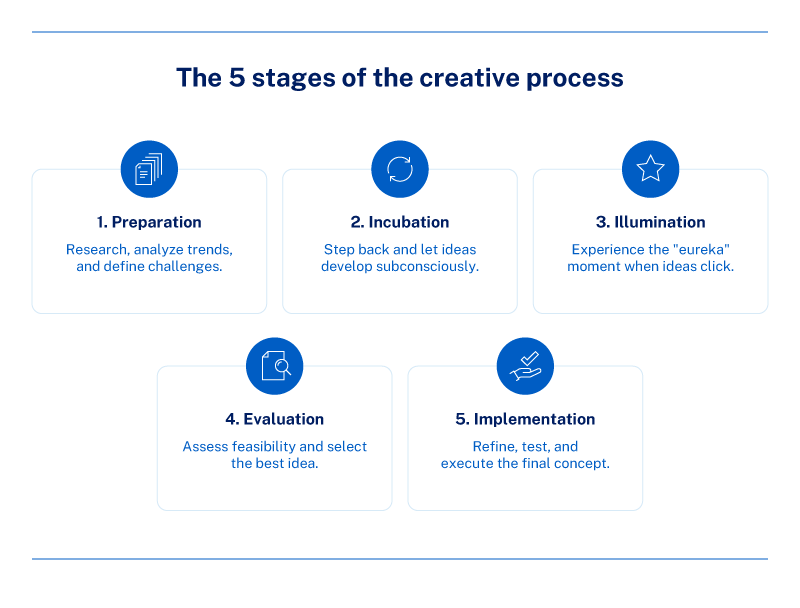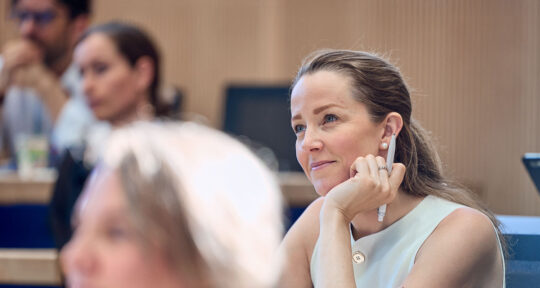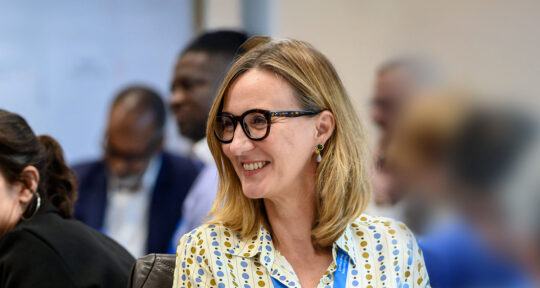Creativity powers modern business success, yet many leaders struggle to harness its full potential due to rigid structures, risk-averse cultures, and a lack of practical tools to turn ideas into action. Without the right environment and support, even the best ideas can stall before they deliver real impact.
The five-stage creative process – preparation, incubation, illumination, evaluation, and implementation – is a framework for transforming abstract ideas into market-ready solutions.
This article explores how each stage contributes to innovation to help you create a business environment where creative thinking flourishes and ideas evolve into competitive advantages.
- Why creativity matters in business
- The creative process: a 5-step breakdown
- Foster creativity for business success
Why creativity matters in business
In markets where disruption happens daily, creativity separates industry leaders from followers. When organizations harness creative thinking, they discover pathways to growth that competitors often miss. Strategic decision-making transforms when fueled by creativity.
LEGO’s turnaround story demonstrates creativity’s problem-solving power. Facing bankruptcy in the early 2000s, the company tapped into its creative potential by reimagining its entire approach. The company’s focus on storytelling and community engagement sparked a revival that extended into entertainment, digital experiences, and retail innovation.
The most successful leaders recognize creativity as a competitive asset and integrate it into their organizational culture. By building environments that nurture the creative mind, companies develop distinctive products, more effective strategies, and deeper customer connections – turning creative work into market advantages that drive lasting success.
Graham Wallas and the art of thought
In 1926, Graham Wallas introduced a framework that continues to shape our understanding of creativity. His influential work, “The Art of Thought,” outlined four stages that form the cognitive foundation of innovation.
These four stages – preparation, incubation, illumination, and verification – capture how creative people naturally generate and refine ideas. Wallas observed that creative genius doesn’t arrive randomly but follows predictable patterns that balance conscious effort with unconscious processing.
While Wallas’ model remains a cornerstone of creative theory, modern business applications have expanded on it by splitting the verification step into two phases: evaluation and implementation. This emphasizes the need for assessing ideas before moving into full implementation, making the process more structured and applicable in a business setting.
The creative process: a 5-step breakdown
Understanding creativity requires recognizing its sequential nature. The creative process unfolds through preparation, incubation, illumination, evaluation, and implementation. Each stage builds upon the previous one, creating a framework where original ideas develop, strengthen, and eventually materialize.
This approach works across industries and disciplines, providing structure to what might otherwise seem like chaotic creative work. Teams engaged in brainstorming for a creative project can intentionally move through these different stages, forming new connections that might otherwise remain undiscovered.
1. The preparation stage: setting the foundation
The preparation stage establishes the groundwork for innovation. It’s when teams gather information and clearly define challenges before attempting solutions.
Critical thinking flourishes when leaders encourage exploration beyond conventional formats. Lay the groundwork with:
- Market analysis: Conducting thorough research into customer needs, competitor offerings, and industry trends helps identify genuine opportunities worth pursuing.
- Problem definition workshops: Bringing together diverse perspectives to precisely frame challenges helps teams solve the right problems rather than just the symptoms.
- Knowledge mapping: Creating visual representations of existing information can highlight gaps and connections that might otherwise remain hidden.
- Customer interviews: Speaking directly with users often reveals pain points and desires that formal research might miss, generating creative ideas in response to real needs.
- Immersive experiences: Having team members use products or services firsthand creates an emotional understanding that data alone cannot provide.
2. The incubation stage: letting ideas develop
During incubation, the mind processes information below conscious awareness. This seemingly inactive period allows the creative mind to form connections between seemingly unrelated concepts.
When teams step away from intense focus, they often experience breakthroughs. The incubation stage works best when people have time to let their minds wander.
Support this natural cognitive process with:
- Scheduled breaks: Building deliberate pauses into work sessions helps prevent mental fatigue and creates space for subconscious processing to occur.
- Walking meetings: Combining light physical activity with conversation stimulates blood flow to the brain while removing participants from typical meeting environments.
- Environmental changes: Moving to different physical locations throughout the day helps the brain form new associations and break out of fixed thinking patterns.
- Cross-departmental lunches: Informal conversations with colleagues from different areas often spark unexpected insights that wouldn’t emerge in structured settings. It also promotes team building.
- Task shifting: Alternating between different types of work allows ideas to develop in the background while attention focuses elsewhere.
Leaders can enhance this natural part of their team’s own creative process by structuring work with deliberate pause points. This creates space for subconscious processing that often yields unexpected insights.
3. Eureka! The illumination stage
The illumination stage represents that magical moment when clarity emerges from confusion. You can help eureka moments flourish by implementing:
- Flexible scheduling: Allowing teams to work when they feel most creative rather than adhering to rigid timetables encourages natural thought development and helps capture inspiration when it strikes.
- Dedicated thinking spaces: Creating areas specifically designed for contemplation – from comfortable lounges to outdoor walking paths – helps shift thinking patterns and removes employees from environments associated with routine tasks.
- Psychological safety: Fostering environments where sharing incomplete ideas isn’t penalized makes people more willing to voice emerging concepts before they’re fully formed.
- Cross-disciplinary interaction: Facilitating conversations between departments often sparks unexpected connections as diverse knowledge bases collide and create new perspectives on existing challenges.
- Inspiration immersion: Surround teams with stimulating materials related to their challenges, such as mood boards and visual collages, case studies and success stories, and creative triggers like product packaging, food presentation, architecture, and interior design elements.
- Collaborative sessions: Scheduled time for diverse thinkers to exchange perspectives often triggers creative genius that rarely emerges in isolation and builds on collective intelligence.
The most innovative organizations recognize that creative thinking flourishes when these elements work together as a cohesive system. When business leaders understand how the creative process works, they can systematically increase innovation rather than waiting for random inspiration.
For example, Pixar fosters creativity by combining open communication, candid feedback, and iterative collaboration – all supported by leadership that actively protects space for experimentation.
4. Evaluation: Selecting the best idea
After generating creative solutions, teams must determine which ideas merit development. This critical phase prevents wasting resources on concepts that won’t deliver results.
To ensure clarity and consistency, document each evaluation step in a centralized innovation tracker or shared digital workspace. This allows teams to revisit decisions, align stakeholders, and build on past learning.
Strengthen your evaluation process with:
- Decision matrices: Creating scoring systems that rate each creative idea against criteria like market potential, implementation difficulty, and alignment with strategy provides objective comparison.
- Stakeholder feedback sessions: Gathering input from customers, frontline employees, and technical experts reveals blind spots and refines concepts before significant investment.
- SWOT analysis: Examining strengths, weaknesses, opportunities, and threats for each concept helps teams anticipate challenges and leverage advantages.
- Cost-benefit projections: Estimating resource requirements against potential returns helps determine which ideas are worth pursuing from a financial perspective.
- Pilot planning: Mapping out small-scale tests identifies what information teams need before committing to full implementation.
5. Implementation: Testing ideas
The final stage transforms promising concepts into practical solutions through testing and refinement. This validation process ensures ideas deliver their expected value before full implementation. To gauge success, define clear metrics upfront and track them consistently throughout the testing phase. These may include user engagement levels, error rates, cost-to-build vs. value created, or time-to-market.
Validate your concepts through:
- Rapid prototyping: Creating simplified versions of products or services allows teams to gather feedback on core functionality without excessive investment.
- Usability testing: Observing how people interact with prototypes reveals unexpected challenges and opportunities for improvement.
- A/B experiments: Testing variations of concepts with different user groups provides data-driven insights for decision-making.
- Minimum viable products: Launching stripped-down versions to early adopters generates real-world feedback while minimizing risk.
- Phased implementation: Gradually expanding successful pilots allows for continued elaboration based on emerging insights.
Verification requires balancing creativity with practical considerations. The most successful organizations maintain openness to refinement throughout this process, recognizing that ideas worth pursuing often evolve significantly before reaching their final form.

Foster creativity for business success
The five-stage creative process transforms abstract ideas into market-ready innovations. Organizations that support each stage unlock their teams’ creative potential and gain significant competitive advantages.
Businesses that embrace creative thinking enjoy stronger decision-making, innovative solutions, and greater adaptability. These organizations recognize that creativity isn’t just artistic expression – it’s a systematic approach to problem-solving that drives measurable results.
Ready to transform your organization’s approach to innovation? Enroll in the “Business Creativity and Innovation Sprint” to develop practical skills for generating breakthrough ideas. This intensive program equips leaders with techniques for navigating each creative stage – from preparation to implementation.
Led by IMD faculty with expertise in creativity and innovation, this learning journey combines theoretical frameworks with hands-on practice. Participants develop a personal creativity toolkit while collaborating with peers from diverse industries to solve real business challenges.
The program emphasizes that creative potential exists in everyone, not just those with traditionally “creative” roles. Through structured exercises and expert coaching, you’ll discover reliable methods to activate the creative mind throughout your organization.
Want to build a culture where innovation thrives? Explore IMD’s innovation programs to gain the tools, frameworks and mindset to turn bold ideas into lasting business impact. These programs help you challenge the status quo, lead with agility, and stay ahead of industry disruption.
Stay up to date 💌
Join the IMD Community.
Stay informed with our latest insights on leadership, strategy, digital transformation and more. Explore fresh perspectives from IMD business school to help you navigate today’s complex business landscape.




